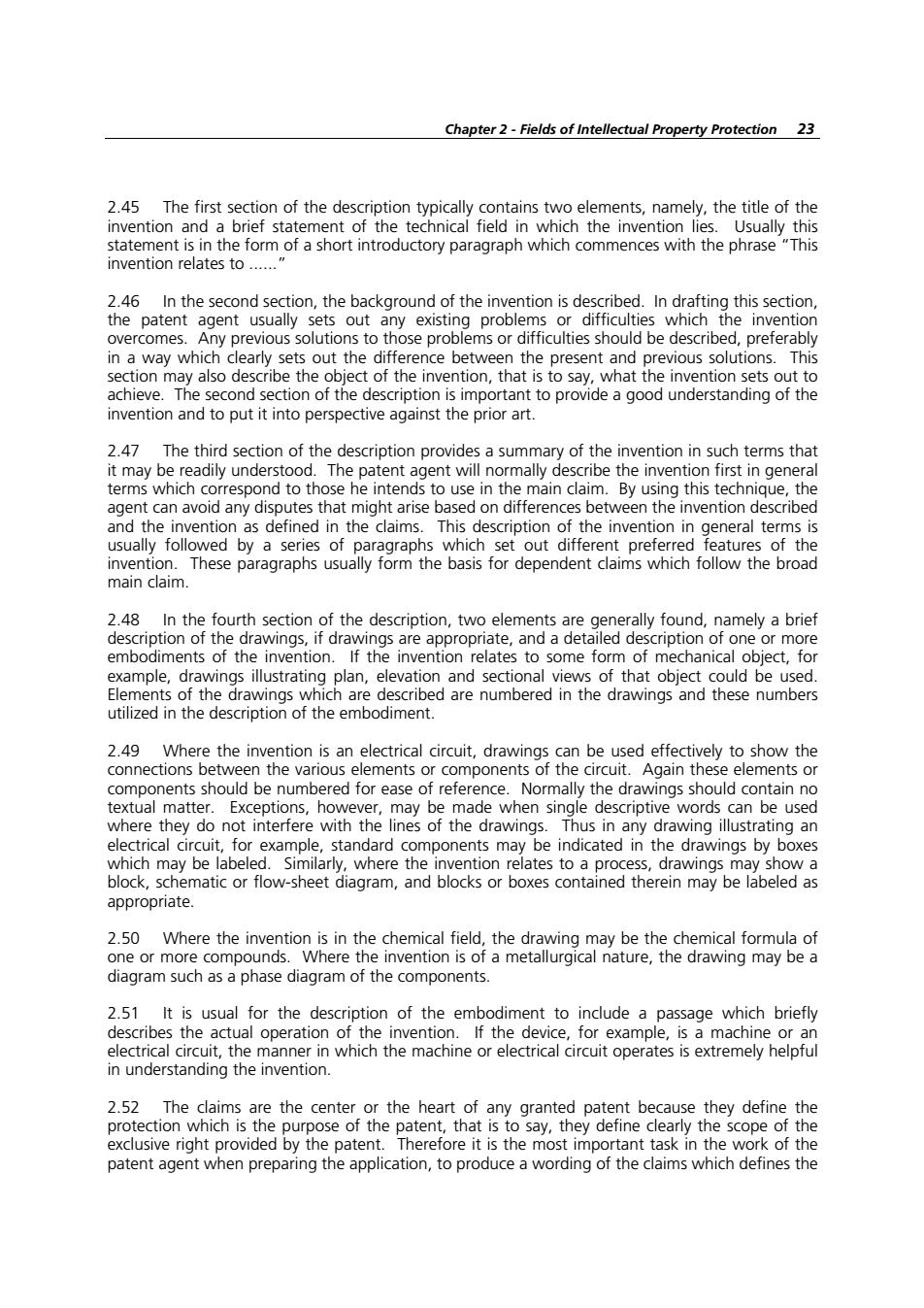
Chapter 2-Fields of Intellectual Property Protection 23 and e of the statement is in the form of a short introductory paragraph which commences with the phraseThis nvention re htio,the background of the nvntis cribed.In drafting this section uld be d in a way which clearly sets out the difference between the present and previous solutions.This to pr a go e s which c to those he inten ds to use in th main claim.By us ng this technique,the y wee usually followed by a series of paragraphs which set out different preferred atur of the These paragraphs usually form the basis for dependent claims which follow the broad of the invention.f the invention relates to some form of mechanical oect.for number should be numbered for ease of f refer Normally the drawings should contain n ith the lines of the d en sin Thus in electrical circuit,for example,standard components may be indicated in the drawings by boxes which may be lab or flow Similarly,where th lates to a process drawinds may show a appropriate. 25eodereoheneaio05eethehemilfetahecawiaT2ytehnemcagonmybeo 250 the al fo ula o diagram such as a phase diagram of the components. 2.51 It is usual for the description of the embodiment to include a passage which briefly describes the actual operation o art any granted ney defin ihe ouo o he。 of the exclusive right provided by the patent. patent agent when preparing the application,to produce a wording of the claims which defines the
Chapter 2 - Fields of Intellectual Property Protection 23 2.45 The first section of the description typically contains two elements, namely, the title of the invention and a brief statement of the technical field in which the invention lies. Usually this statement is in the form of a short introductory paragraph which commences with the phrase “This invention relates to ......” 2.46 In the second section, the background of the invention is described. In drafting this section, the patent agent usually sets out any existing problems or difficulties which the invention overcomes. Any previous solutions to those problems or difficulties should be described, preferably in a way which clearly sets out the difference between the present and previous solutions. This section may also describe the object of the invention, that is to say, what the invention sets out to achieve. The second section of the description is important to provide a good understanding of the invention and to put it into perspective against the prior art. 2.47 The third section of the description provides a summary of the invention in such terms that it may be readily understood. The patent agent will normally describe the invention first in general terms which correspond to those he intends to use in the main claim. By using this technique, the agent can avoid any disputes that might arise based on differences between the invention described and the invention as defined in the claims. This description of the invention in general terms is usually followed by a series of paragraphs which set out different preferred features of the invention. These paragraphs usually form the basis for dependent claims which follow the broad main claim. 2.48 In the fourth section of the description, two elements are generally found, namely a brief description of the drawings, if drawings are appropriate, and a detailed description of one or more embodiments of the invention. If the invention relates to some form of mechanical object, for example, drawings illustrating plan, elevation and sectional views of that object could be used. Elements of the drawings which are described are numbered in the drawings and these numbers utilized in the description of the embodiment. 2.49 Where the invention is an electrical circuit, drawings can be used effectively to show the connections between the various elements or components of the circuit. Again these elements or components should be numbered for ease of reference. Normally the drawings should contain no textual matter. Exceptions, however, may be made when single descriptive words can be used where they do not interfere with the lines of the drawings. Thus in any drawing illustrating an electrical circuit, for example, standard components may be indicated in the drawings by boxes which may be labeled. Similarly, where the invention relates to a process, drawings may show a block, schematic or flow-sheet diagram, and blocks or boxes contained therein may be labeled as appropriate. 2.50 Where the invention is in the chemical field, the drawing may be the chemical formula of one or more compounds. Where the invention is of a metallurgical nature, the drawing may be a diagram such as a phase diagram of the components. 2.51 It is usual for the description of the embodiment to include a passage which briefly describes the actual operation of the invention. If the device, for example, is a machine or an electrical circuit, the manner in which the machine or electrical circuit operates is extremely helpful in understanding the invention. 2.52 The claims are the center or the heart of any granted patent because they define the protection which is the purpose of the patent, that is to say, they define clearly the scope of the exclusive right provided by the patent. Therefore it is the most important task in the work of the patent agent when preparing the application, to produce a wording of the claims which defines the
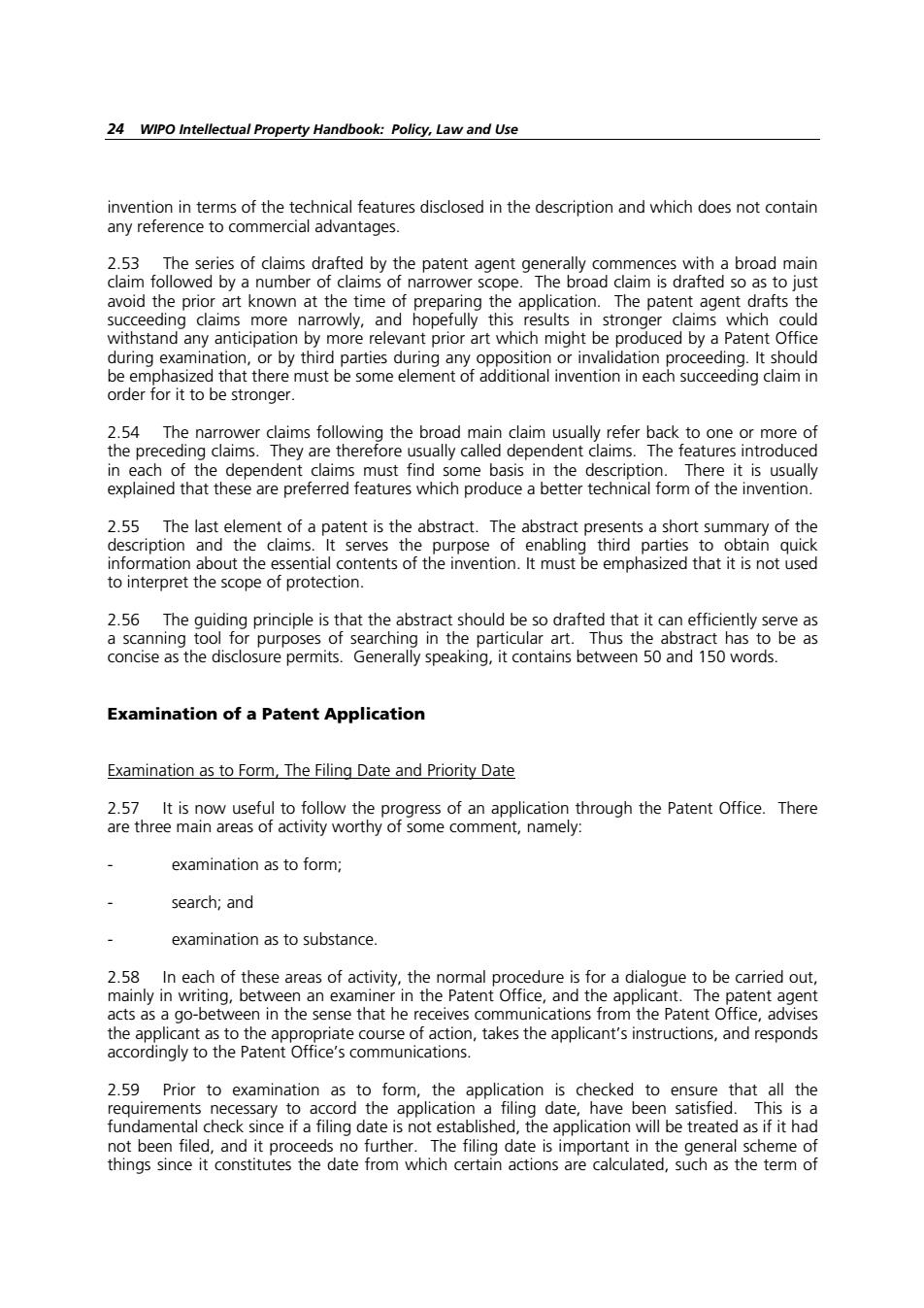
24 WIPO Intellectual Property Handbook:Policy,Law and Use invention in te any retere oMtheeihncal eatures disclosed in the description and which does not contain dvantages 253obe2Giatdapsretetoteaaetra28pt9eneaaaaeme5aieabrado avoid the prior art known at the time of pre lication The patent agent drafts the succeding claim stronger claims during examination,or by third parties durin sition or invalidation p reeding.It should there must be some element of additional invention in each succeedng caim in the preene cainer amer ntouc ey are there st uall in th xptht esr preferred featureiprodubetter icform ofthinveto 2.55 The last ele nt is the abstract Th a shor of the eof thembe mie that itot e of protec 2.56nTe9dngpmincpesohathenttactopanbogthegthatnoial8eea eaking,it contains between 50 and 150 words. Examination of a Patent Application Examination as to Form,The Filing Date and Priority Date seful to follow the progress of an application through the Patent Office.There some comment,namely examination as to form; search;and examination as to substance 2.58 In each of these areas of activity,the normal procedure is for a dialogue to be carried out, mainly in writi ng,betv an exam th office.and the appl batent agen the applicant as to the opriate course of action,takes the applicant's instructions,and responds toth Patemco 2.59 Prior to examination as to form,the application is checked to ensure that all the cord satist a f ndate have be furthe not the filing eis in e treat dat
24 WIPO Intellectual Property Handbook: Policy, Law and Use invention in terms of the technical features disclosed in the description and which does not contain any reference to commercial advantages. 2.53 The series of claims drafted by the patent agent generally commences with a broad main claim followed by a number of claims of narrower scope. The broad claim is drafted so as to just avoid the prior art known at the time of preparing the application. The patent agent drafts the succeeding claims more narrowly, and hopefully this results in stronger claims which could withstand any anticipation by more relevant prior art which might be produced by a Patent Office during examination, or by third parties during any opposition or invalidation proceeding. It should be emphasized that there must be some element of additional invention in each succeeding claim in order for it to be stronger. 2.54 The narrower claims following the broad main claim usually refer back to one or more of the preceding claims. They are therefore usually called dependent claims. The features introduced in each of the dependent claims must find some basis in the description. There it is usually explained that these are preferred features which produce a better technical form of the invention. 2.55 The last element of a patent is the abstract. The abstract presents a short summary of the description and the claims. It serves the purpose of enabling third parties to obtain quick information about the essential contents of the invention. It must be emphasized that it is not used to interpret the scope of protection. 2.56 The guiding principle is that the abstract should be so drafted that it can efficiently serve as a scanning tool for purposes of searching in the particular art. Thus the abstract has to be as concise as the disclosure permits. Generally speaking, it contains between 50 and 150 words. Examination of a Patent Application Examination as to Form, The Filing Date and Priority Date 2.57 It is now useful to follow the progress of an application through the Patent Office. There are three main areas of activity worthy of some comment, namely: - examination as to form; - search; and - examination as to substance. 2.58 In each of these areas of activity, the normal procedure is for a dialogue to be carried out, mainly in writing, between an examiner in the Patent Office, and the applicant. The patent agent acts as a go-between in the sense that he receives communications from the Patent Office, advises the applicant as to the appropriate course of action, takes the applicant’s instructions, and responds accordingly to the Patent Office’s communications. 2.59 Prior to examination as to form, the application is checked to ensure that all the requirements necessary to accord the application a filing date, have been satisfied. This is a fundamental check since if a filing date is not established, the application will be treated as if it had not been filed, and it proceeds no further. The filing date is important in the general scheme of things since it constitutes the date from which certain actions are calculated, such as the term of
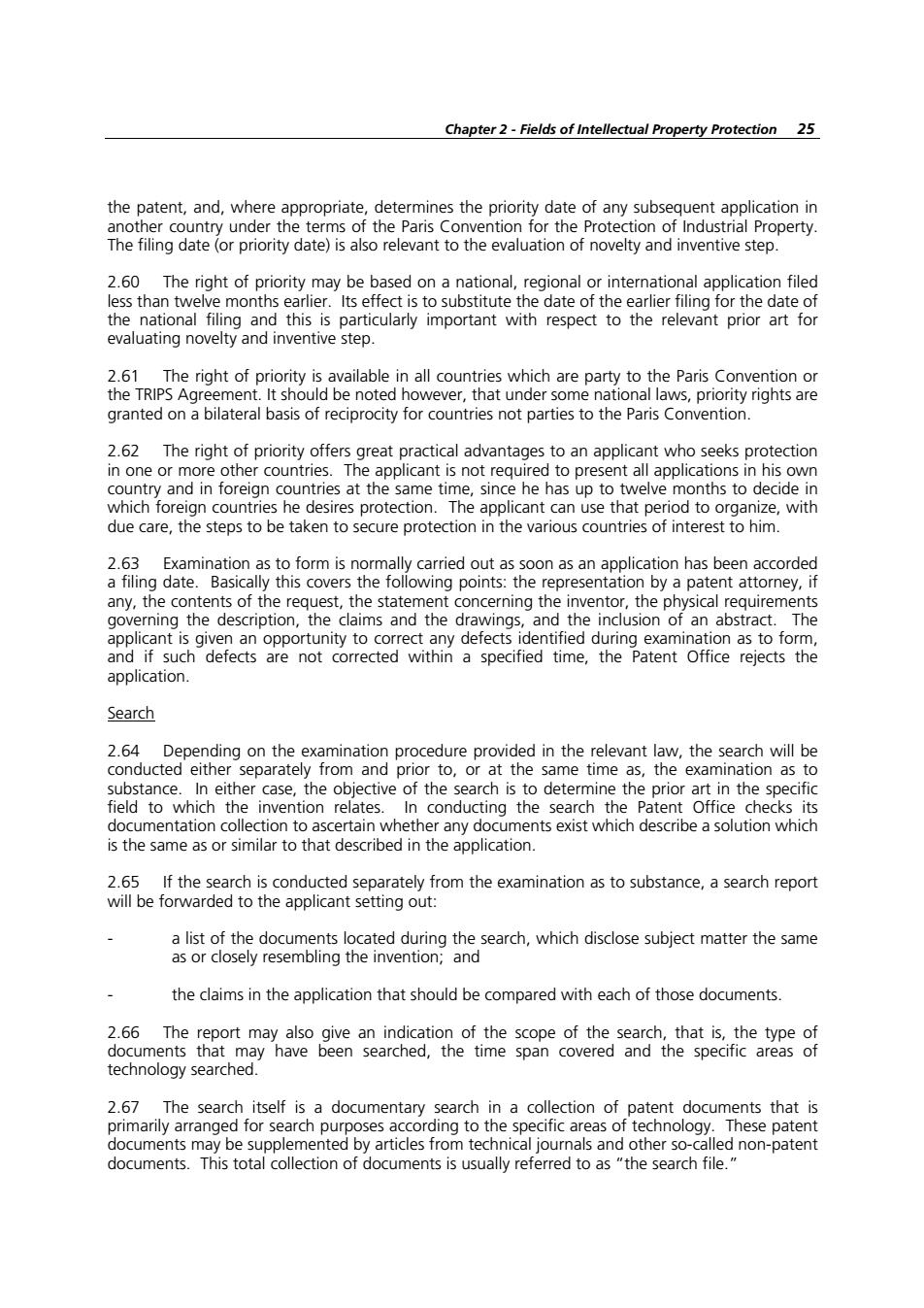
Chapter 2-Fields of Intellectual Property Protection 25 The fing date or priority date)is aso relevant to the evaluation of novelty and inventive step. perty 2 60 the right of priority may be based on a national.regional or international application filed less than twelve months earlier.Its effect is to substitute the date of the earlier filing for the date o the nationa ing and thi carly important with o country and in foreign countries at the same time,since he has up to out as soon as an applica bee any,the contents of the request,the statement concerning the inventor,the physical requirement governing the description, ims and the drawings, to fo andif sufr nthnm.thePtentectthe application. Search eithe case,the objective of the o deter e the AC g th n which is the same as or similar to that described in the application. 2.65 f th ly from the examination as to substance,a search report lict o tod du the claims in the application that should be compared with each of those documents. 2.66 The r me span covere 2.67 The searc bhepeleioeasodfatento8ocumekhatni documents may be supplemented by articles from technical joumnals and other so-called non-patent documents.This total collection of documents is usually referred to as "the search file
Chapter 2 - Fields of Intellectual Property Protection 25 the patent, and, where appropriate, determines the priority date of any subsequent application in another country under the terms of the Paris Convention for the Protection of Industrial Property. The filing date (or priority date) is also relevant to the evaluation of novelty and inventive step. 2.60 The right of priority may be based on a national, regional or international application filed less than twelve months earlier. Its effect is to substitute the date of the earlier filing for the date of the national filing and this is particularly important with respect to the relevant prior art for evaluating novelty and inventive step. 2.61 The right of priority is available in all countries which are party to the Paris Convention or the TRIPS Agreement. It should be noted however, that under some national laws, priority rights are granted on a bilateral basis of reciprocity for countries not parties to the Paris Convention. 2.62 The right of priority offers great practical advantages to an applicant who seeks protection in one or more other countries. The applicant is not required to present all applications in his own country and in foreign countries at the same time, since he has up to twelve months to decide in which foreign countries he desires protection. The applicant can use that period to organize, with due care, the steps to be taken to secure protection in the various countries of interest to him. 2.63 Examination as to form is normally carried out as soon as an application has been accorded a filing date. Basically this covers the following points: the representation by a patent attorney, if any, the contents of the request, the statement concerning the inventor, the physical requirements governing the description, the claims and the drawings, and the inclusion of an abstract. The applicant is given an opportunity to correct any defects identified during examination as to form, and if such defects are not corrected within a specified time, the Patent Office rejects the application. Search 2.64 Depending on the examination procedure provided in the relevant law, the search will be conducted either separately from and prior to, or at the same time as, the examination as to substance. In either case, the objective of the search is to determine the prior art in the specific field to which the invention relates. In conducting the search the Patent Office checks its documentation collection to ascertain whether any documents exist which describe a solution which is the same as or similar to that described in the application. 2.65 If the search is conducted separately from the examination as to substance, a search report will be forwarded to the applicant setting out: - a list of the documents located during the search, which disclose subject matter the same as or closely resembling the invention; and - the claims in the application that should be compared with each of those documents. 2.66 The report may also give an indication of the scope of the search, that is, the type of documents that may have been searched, the time span covered and the specific areas of technology searched. 2.67 The search itself is a documentary search in a collection of patent documents that is primarily arranged for search purposes according to the specific areas of technology. These patent documents may be supplemented by articles from technical journals and other so-called non-patent documents. This total collection of documents is usually referred to as “the search file
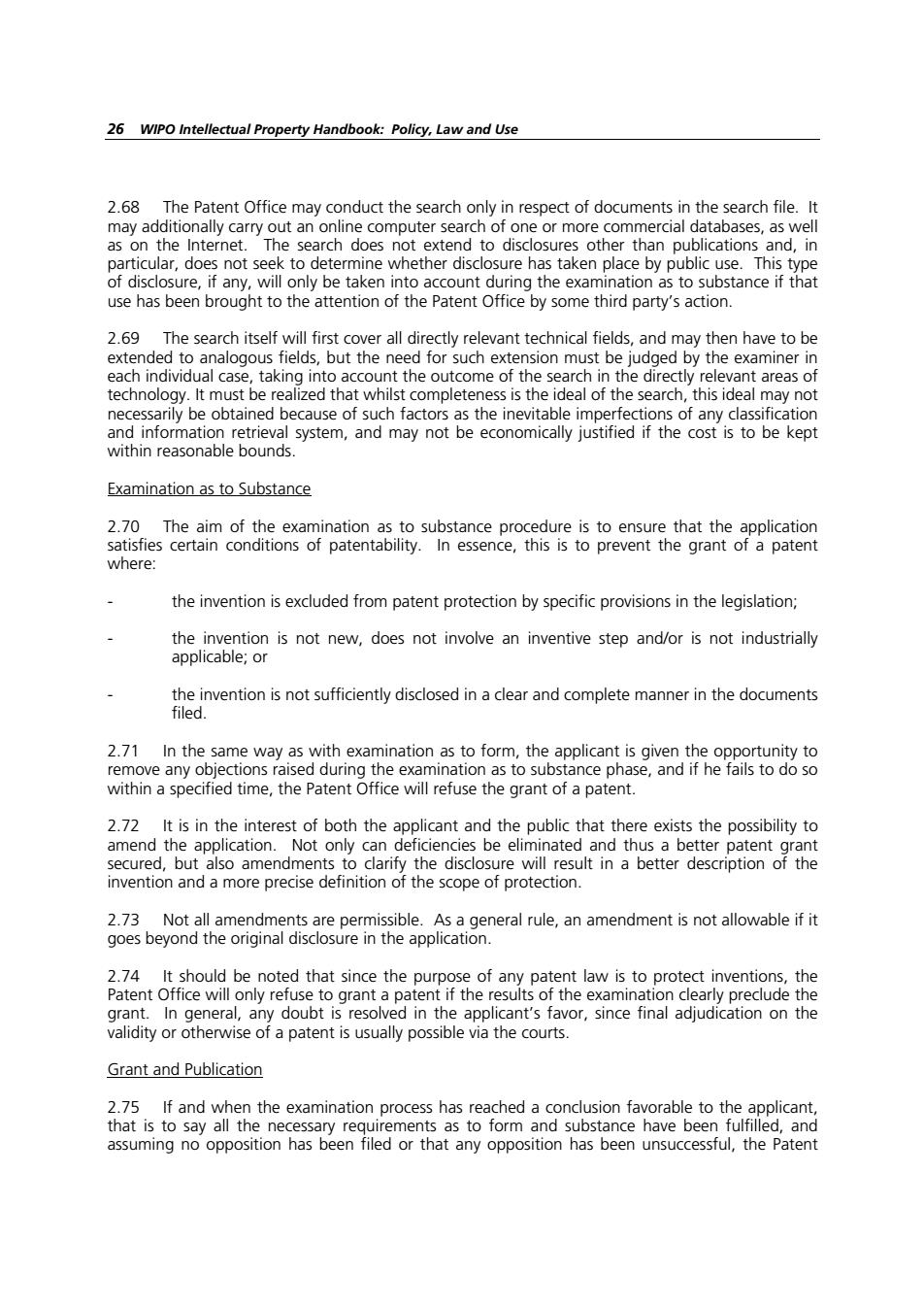
26 WIPO Intellectual Property Handbook:Policy,Law and Use 2.68 search file. as on the Intemnet.The search does not extend to disclosures other than publications and,in does not se ermine whether disclosure h taker place by publ use has been brought to the attention of the Patent Office by some third party's action ehnncduhalcase oustesbuthenedroryueamtiecthnialfes,andi ion must he iudaed by the he dire he obtained be f ch factors as the in he sea of andniontomeeGd I system,and may not be economically justified if the cost is to be kept within reaso Examination as to Substance 2a7gesTcenaodnhocsaotrpiemnast9bstanenogursteeatnthgraheoPgkatom 770 subst. where: the invention is excluded from patent protection by specific provisions in the legislation; 27 e n the ehsame way as wi within a specified time,the Patent Office will refuse the grant of a patent. the nossibility to 2.73 Not all amendm nt law is to protect inventions,the y re doub grant a p in th nt's fa vyorepatentisall the cours Grant and Publication assuming no opposition has been filed or that any opposition has been unsuccessful,the Patent
26 WIPO Intellectual Property Handbook: Policy, Law and Use 2.68 The Patent Office may conduct the search only in respect of documents in the search file. It may additionally carry out an online computer search of one or more commercial databases, as well as on the Internet. The search does not extend to disclosures other than publications and, in particular, does not seek to determine whether disclosure has taken place by public use. This type of disclosure, if any, will only be taken into account during the examination as to substance if that use has been brought to the attention of the Patent Office by some third party’s action. 2.69 The search itself will first cover all directly relevant technical fields, and may then have to be extended to analogous fields, but the need for such extension must be judged by the examiner in each individual case, taking into account the outcome of the search in the directly relevant areas of technology. It must be realized that whilst completeness is the ideal of the search, this ideal may not necessarily be obtained because of such factors as the inevitable imperfections of any classification and information retrieval system, and may not be economically justified if the cost is to be kept within reasonable bounds. Examination as to Substance 2.70 The aim of the examination as to substance procedure is to ensure that the application satisfies certain conditions of patentability. In essence, this is to prevent the grant of a patent where: - the invention is excluded from patent protection by specific provisions in the legislation; - the invention is not new, does not involve an inventive step and/or is not industrially applicable; or - the invention is not sufficiently disclosed in a clear and complete manner in the documents filed. 2.71 In the same way as with examination as to form, the applicant is given the opportunity to remove any objections raised during the examination as to substance phase, and if he fails to do so within a specified time, the Patent Office will refuse the grant of a patent. 2.72 It is in the interest of both the applicant and the public that there exists the possibility to amend the application. Not only can deficiencies be eliminated and thus a better patent grant secured, but also amendments to clarify the disclosure will result in a better description of the invention and a more precise definition of the scope of protection. 2.73 Not all amendments are permissible. As a general rule, an amendment is not allowable if it goes beyond the original disclosure in the application. 2.74 It should be noted that since the purpose of any patent law is to protect inventions, the Patent Office will only refuse to grant a patent if the results of the examination clearly preclude the grant. In general, any doubt is resolved in the applicant’s favor, since final adjudication on the validity or otherwise of a patent is usually possible via the courts. Grant and Publication 2.75 If and when the examination process has reached a conclusion favorable to the applicant, that is to say all the necessary requirements as to form and substance have been fulfilled, and assuming no opposition has been filed or that any opposition has been unsuccessful, the Patent
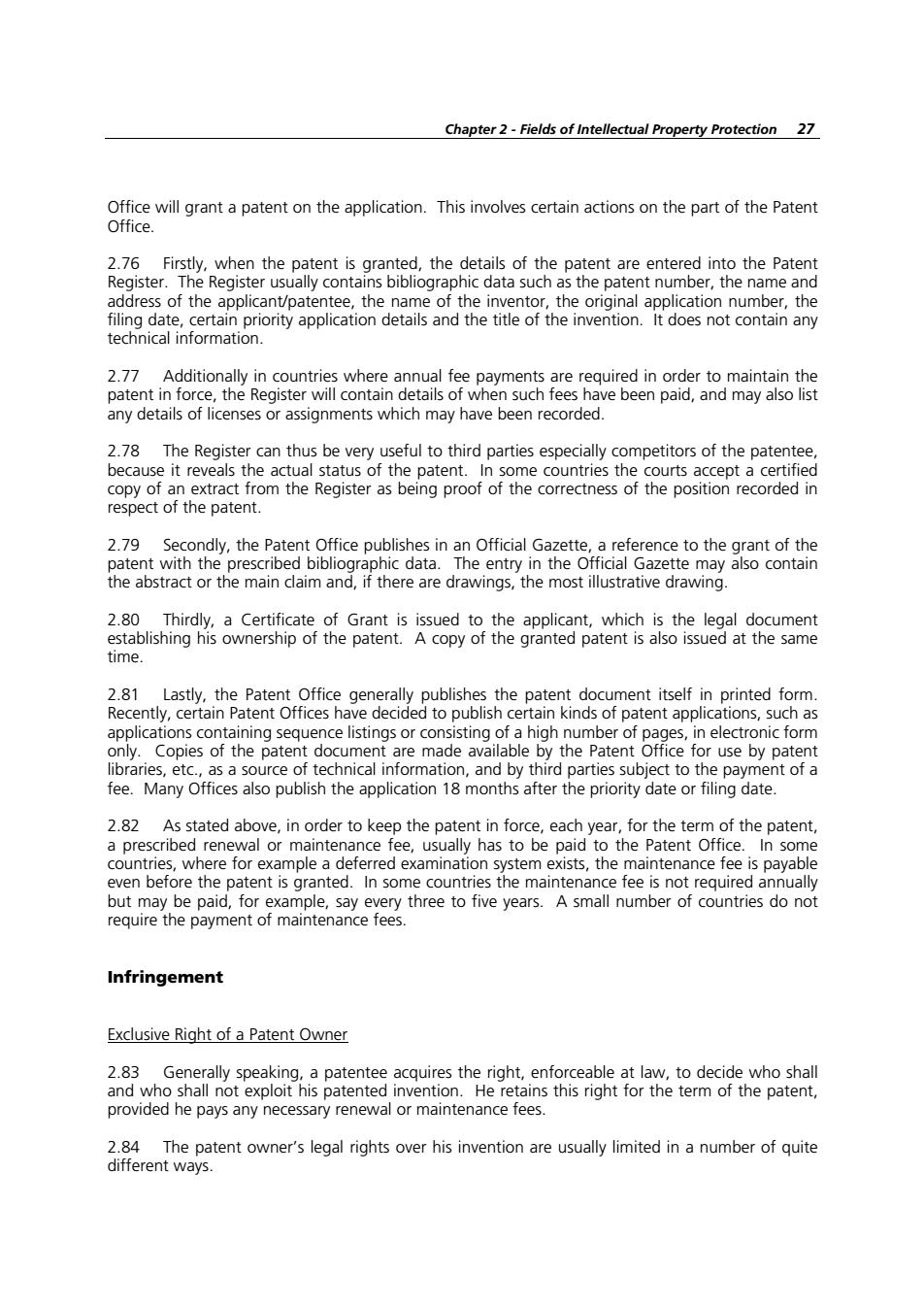
Chapter 2-Fields of Intellectual Property Protection 27 8ewgrantapiemontheapicaonsnmoeatanaiosomtepaRothePaemt Offic 6 filing the applicant/patentee,the name of the inventor,the original application number,the 2.77 Acotanalgegeentwi t i where annual fe Th p use it rev e very f the ful to + natent me oun mthe Register as being poo of the corecte of the position erddn copy of 2.79 Secondly,the Patent Office publishes in an Official Gazette,a reference to the grant of the time. n electronic form third parties subiect to the ent of a fee.Many Offices also publish the application 18 months after the priority date or filing date. 2 82 as stated above in order to keep the patent in force a prescribed renewal or maintenance fee,usually has to be paid t e,each year,for the term of the patent o the Patent Office.In some coentpeoeheeforeaglenieceferedeenatotemee, mainter nce tee is payat but may be paid,for exan three to five years.A small number of countries do not require the payment of maintenance fees. Infringement Exclusive Right of a Patent Owner 2.83 provided he pays any necessary renewal or maintenance fees. 2aemegentonerslegaligsoerhsnentonaeuaymiednantgrofauie
Chapter 2 - Fields of Intellectual Property Protection 27 Office will grant a patent on the application. This involves certain actions on the part of the Patent Office. 2.76 Firstly, when the patent is granted, the details of the patent are entered into the Patent Register. The Register usually contains bibliographic data such as the patent number, the name and address of the applicant/patentee, the name of the inventor, the original application number, the filing date, certain priority application details and the title of the invention. It does not contain any technical information. 2.77 Additionally in countries where annual fee payments are required in order to maintain the patent in force, the Register will contain details of when such fees have been paid, and may also list any details of licenses or assignments which may have been recorded. 2.78 The Register can thus be very useful to third parties especially competitors of the patentee, because it reveals the actual status of the patent. In some countries the courts accept a certified copy of an extract from the Register as being proof of the correctness of the position recorded in respect of the patent. 2.79 Secondly, the Patent Office publishes in an Official Gazette, a reference to the grant of the patent with the prescribed bibliographic data. The entry in the Official Gazette may also contain the abstract or the main claim and, if there are drawings, the most illustrative drawing. 2.80 Thirdly, a Certificate of Grant is issued to the applicant, which is the legal document establishing his ownership of the patent. A copy of the granted patent is also issued at the same time. 2.81 Lastly, the Patent Office generally publishes the patent document itself in printed form. Recently, certain Patent Offices have decided to publish certain kinds of patent applications, such as applications containing sequence listings or consisting of a high number of pages, in electronic form only. Copies of the patent document are made available by the Patent Office for use by patent libraries, etc., as a source of technical information, and by third parties subject to the payment of a fee. Many Offices also publish the application 18 months after the priority date or filing date. 2.82 As stated above, in order to keep the patent in force, each year, for the term of the patent, a prescribed renewal or maintenance fee, usually has to be paid to the Patent Office. In some countries, where for example a deferred examination system exists, the maintenance fee is payable even before the patent is granted. In some countries the maintenance fee is not required annually but may be paid, for example, say every three to five years. A small number of countries do not require the payment of maintenance fees. Infringement Exclusive Right of a Patent Owner 2.83 Generally speaking, a patentee acquires the right, enforceable at law, to decide who shall and who shall not exploit his patented invention. He retains this right for the term of the patent, provided he pays any necessary renewal or maintenance fees. 2.84 The patent owner’s legal rights over his invention are usually limited in a number of quite different ways